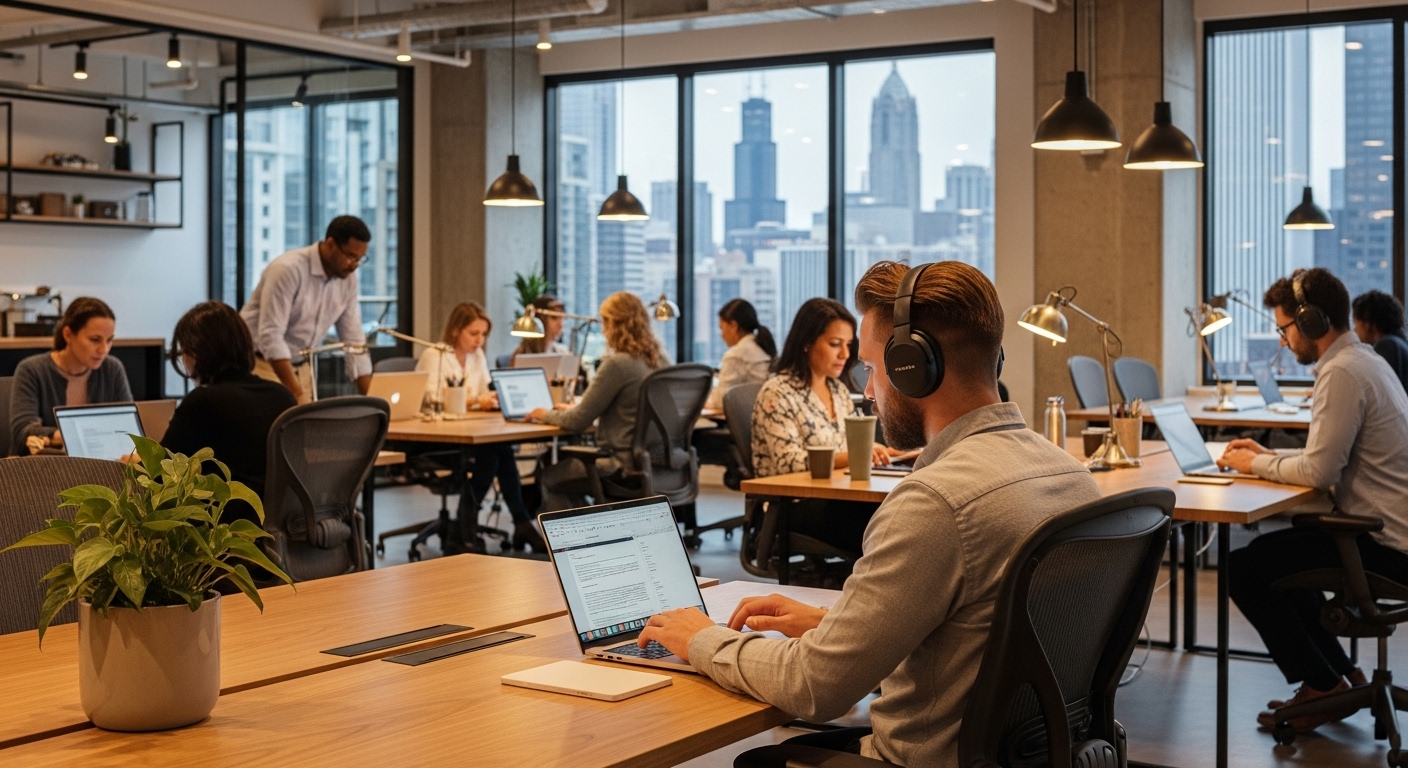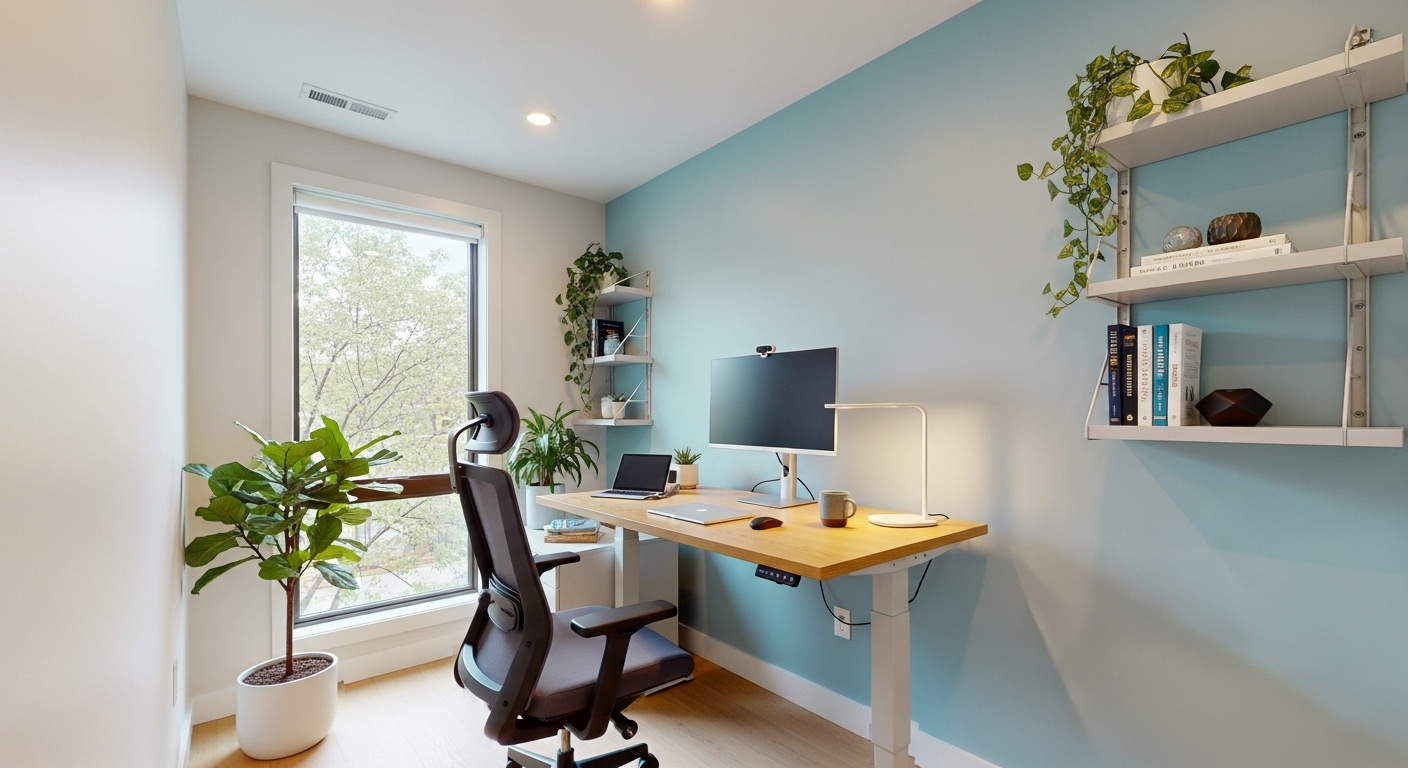In the vibrant, ever-moving world of a coworking space, the promise of collaborative energy can often clash with the professional’s need for deep, focused work. The constant hum of conversation, the endless coffee pot runs, and the serendipitous encounters are all part of the appeal, yet they can also be the biggest roadblocks to hitting your deadlines. For the modern professional, the challenge isn’t about escaping this environment but mastering it. This guide moves beyond simple tips and tricks to introduce a more holistic framework: the creation of a personal productivity ecosystem. It’s a tailored system of spaces, tools, and rituals designed to help you harness the benefits of a shared office while carving out the sanctuary you need for peak performance. In a city defined by its architectural ingenuity and relentless drive, building such a system is not just an advantage; it’s a necessity for thriving professionally.
Defining your ecosystem: The three pillars of coworking productivity
A personal productivity ecosystem is not a one-size-fits-all solution but a custom-built framework that aligns with your unique workflow and personality. It stands on three core pillars: your physical environment, your digital toolkit, and your personal rituals. Understanding and optimizing each of these components is the first step toward achieving consistent high output in a dynamic setting. The first pillar, the physical environment, involves more than just your desk. It’s about strategically using every part of the coworking space—from quiet corners and phone booths to collaborative lounges and event areas—as an extension of your personal office. The second pillar is your digital toolkit. This is your virtual fortress of focus, comprised of apps and software that block distractions, organize tasks, and streamline communication, creating a seamless workflow that insulates you from the surrounding chaos. The final pillar, personal rituals, is the human element that ties it all together. These are the habits and routines you consciously cultivate, such as time-blocking, scheduled breaks, and clear communication cues to your fellow coworkers, that transform your workday from reactive to intentional. By deliberately designing how these three pillars interact, you create a resilient system that supports deep work regardless of the external environment.
Mastering your physical domain: Zoning your workspace for deep work
The modern coworking space is a microcosm of a city, with different zones designed for different activities. The key to mastering your physical domain is to treat it as such, consciously assigning specific types of work to specific areas. Your hot desk or dedicated desk should be your command center for focused, high-concentration tasks. This is where you do the deep work—writing, coding, analyzing data. To reinforce this, keep your primary desk clean and optimized for a single purpose. When you need to make calls or attend virtual meetings, migrate to a designated phone booth or private call room. This not only provides better acoustics but also creates a psychological shift, signaling to your brain that it’s time to switch from focused work to communication. For creative brainstorming, collaborative tasks, or casual administrative work, leverage the lounge areas or communal tables. The change in posture and scenery can stimulate different ways of thinking. The diverse array of coworking options across Chicago, from the bustling tech hubs in River North to the creative lofts in the West Loop, provides a perfect testing ground for this zoning strategy. By aligning the task with the space, you reduce decision fatigue and build powerful muscle memory, making the transition between different work modes seamless and efficient.
Curating your digital toolkit: The essential apps for shared space success
While you can’t control the physical noise of a coworking space, you can build a powerful digital sanctuary that shields your focus. Your digital toolkit is the collection of software and applications that act as your first line of defense against distraction and your primary engine for organization. The cornerstone of this toolkit is a robust task management system, such as Asana, Trello, or Todoist, which externalizes your to-do list and frees up mental bandwidth. This allows you to capture ideas and tasks as they arise without breaking your current flow. Next, invest in high-quality, noise-canceling headphones paired with a focus-enhancing app like Brain.fm or a simple ambient noise generator. This combination is crucial for creating an auditory bubble that blocks out distracting conversations and allows you to drop into a state of deep concentration. To manage digital distractions, use website and app blockers like Freedom or Cold Turkey during your designated focus blocks. These tools create hard boundaries that prevent you from mindlessly scrolling through social media or news feeds. Finally, master your team’s communication platform, like Slack or Microsoft Teams. Learn to effectively use statuses, notifications settings, and scheduled messages to signal your availability and batch your communications, preventing the constant drip of messages from dictating your day’s rhythm.
The power of rituals: Structuring your day for predictable output
Your productivity ecosystem is ultimately powered by your personal habits and routines. Without consistent rituals, even the best physical setup and digital tools will fail. The most effective professionals in shared workspaces are not those with the most willpower, but those with the most structured days. Start by implementing a ‘workday startup’ ritual. This 15-minute routine, performed as soon as you sit down, could involve reviewing your task manager, setting your top three priorities for the day, and closing all unnecessary tabs. This creates a clear intention and primes your brain for focus. Throughout the day, use a time-management technique like the Pomodoro Method—working in focused 25-minute sprints with 5-minute breaks—to maintain energy and prevent burnout. These short, scheduled breaks are perfect for grabbing coffee, stretching, or having a quick chat, ensuring that social interaction happens on your terms. Similarly, create a ‘workday shutdown’ ritual. In the last 15 minutes of your day, review what you accomplished, plan your priorities for tomorrow, and tidy your desk. This provides a sense of closure and makes the next morning’s startup ritual far more effective. These structured routines act as the operating system for your productivity, providing a predictable rhythm that allows you to thrive amidst the unpredictability of a shared environment.
Leveraging the collective: Turning community into a productivity asset
One of the greatest paradoxes of coworking is that the community, often a source of distraction, can also be a powerful productivity tool when approached strategically. Instead of viewing your fellow members as potential interruptions, reframe them as a source of motivation, accountability, and knowledge. The key is to shift from reactive socializing to intentional engagement. Dedicate specific times for networking, such as during your scheduled breaks, at lunch, or during official community events. This allows you to reap the benefits of collaboration without letting spontaneous conversations derail your focus blocks. In the collaborative professional landscape of Chicago, these connections can be invaluable for problem-solving and new opportunities. If you’re struggling with a problem, a quick question posed in a communal area can yield a solution in minutes that might have taken you hours to find alone. Furthermore, use the community for accountability. Share your goals with a trusted peer or form a small ‘mastermind’ group that meets weekly to discuss progress and challenges. The simple act of vocalizing your intentions to others creates a powerful psychological commitment. This is the concept of ‘body doubling,’ where the mere presence of others working diligently around you can increase your own motivation and focus. By mastering this balance, you transform the coworking community from a potential liability into your greatest asset.
The distraction defense: Proactive strategies for maintaining focus
Even with a well-designed ecosystem, distractions will inevitably arise. The final layer of your productivity strategy is a proactive defense system designed to manage these interruptions before they take root. The most powerful tool in your arsenal is a clear visual cue. A small, elegant sign on your desk that says ‘In a Focus Block’ or simply wearing your headphones can signal to others that you are not to be disturbed. This non-verbal communication is often more effective and less awkward than verbally turning someone away. Be prepared to politely but firmly protect your time. A simple, ‘I’m in the middle of something right now, can I find you in about 30 minutes?’ is a respectful way to defer a conversation without damaging rapport. Another key strategy is to choose your workspace location wisely. If you know you have a day of deep work ahead, opt for a desk in a designated quiet zone or a spot facing a wall to minimize visual distractions. Conversely, if you have a day of lighter tasks and are open to interaction, choose a seat in a more high-traffic area. Ultimately, maintaining focus is about setting and enforcing boundaries—with others and with yourself. By implementing these proactive defenses, you take control of your attention and ensure that your productivity is a result of your own design, not a victim of circumstance.
In conclusion, achieving peak productivity in a coworking space is not about finding a magic bullet, but about thoughtful design. By architecting a personal productivity ecosystem—a synergistic blend of your physical environment, digital tools, and personal rituals—you can transform a potentially chaotic office into a high-performance hub. This framework empowers you to deliberately zone your workspace for different tasks, build a digital fortress against distraction, and implement routines that drive predictable results. It allows you to strategically leverage the vibrant community for motivation and collaboration while protecting your time for deep, meaningful work. For professionals navigating the dynamic business environment of Chicago, this approach is a powerful competitive advantage. It’s a shift from being a passive occupant of a shared space to becoming an active architect of your own focus and success. Mastering this ecosystem is the key to unlocking the full promise of coworking: the perfect synthesis of collective energy and individual achievement.





